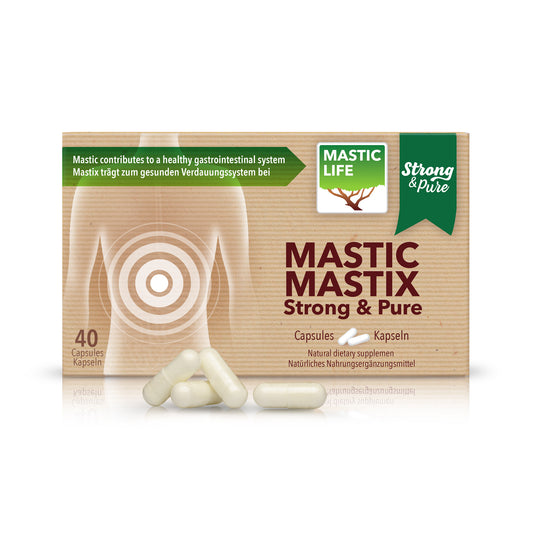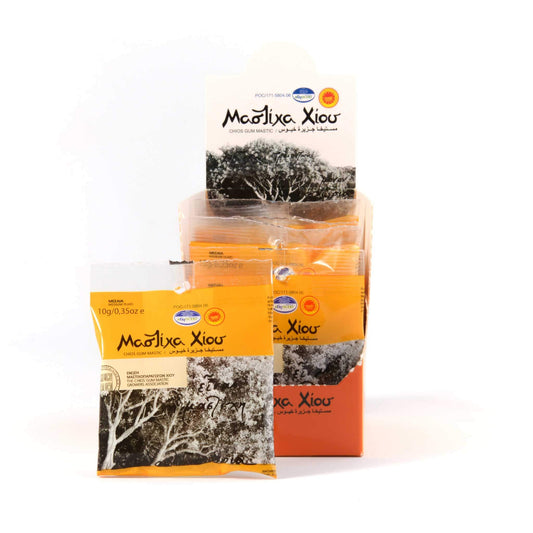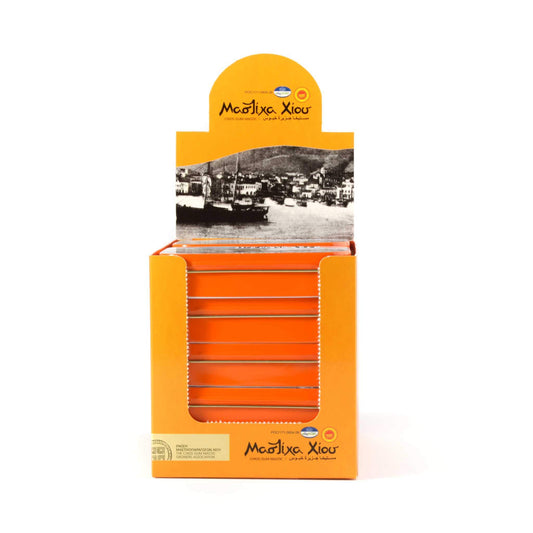Studies: ANTIMICROBIAL ACTIVITY OF CHIOS MASTIC
Apart from the anti-H. pylori activity, Chios Mastic gum shows exceptional antimicrobial, antibacterial and antifungal properties against other microorganisms. In modern times, Abdel-Ghaffar et al (1957) described the biological properties of the resin in Egypt against a bacterium resembling Bacillus subtillis 58.
Other past studies have defined the action of Chios Mastic against numerous food spoilage and foodborne pathogens. Both Gram positive and Gram negative bacteria have been inhibited by the discussed compound in a different extend. The antifungal action of the aqueous extract of Chios Mastic is also remarkable against dermatophytes. Furthermore, Chios Mastic essential oil of has been found to possess certain antimicrobial and antifungal activity, and it has been extensively analyzed in order to determine the exact components which are responsible for its antibacterial characteristics.
Study 1
In 1995, Tassou & Nychas investigated the antimicrobial action of Chios Mastic oil on Staphylococcus aureus, Lactobacillus plantarum, Pseudomonas fragi and Salmonella enteritidis. It was indicated that the oil caused inhibition of the growth of the bacteria. More specifically, Gram positive bacteria were mostly inhibited, compared to the percentage of inhibition of the Gram negative microorganisms 59.
Study 2
In 1999, Ali-Shtayeh and Abu Ghdeib studied Chios Mastic against dermatophytes (Microsporum canis, Trichophyton mentagrophytes and Trichophyton violaceum), and it was found that it inhibited all three microorganisms by 90-100% 60.
Study 3
In 2004, a study was conducted to search the activity of sorbic hydroxamic acid (SHA) and Chios Mastic oil–ethanol (ME) or water-ethanol (WE) emitters on the growth of Bacillus cereus in the conditions of high-moisture and high-pH (~8.9) at ambient temperature (25οC). SHA alone or combined with ME emitters inhibited the growth of the bacteria for 14 days in high-pH crumpets 61.
Study 4
Koukoutsis et al (2004) among others, also studied the effects of various concentrations of potassium sorbate (KS), sorbic hydroxamic acid (SHA), water-ethanol (WE) and Chios Mastic oil-ethanol (Me) emitters, in plenty of pH values on the growth of spoilage and food safety microorganisms (Bacillus cereus, Bacillus subtilis, Salmonella enteriditis, Listeria monocytogenes, Saccharomyces cerevisiae and Penicillium notatum), high-moisture, high-pH products of the bakery industry. Me emitters controlled the growth of most microorganisms, apart from Listeria monocytogenes, for 12 to 28 days on agar plates, and inhibition depended on Chios Mastic volatiles in the package headspace. It is clearly shown that there is a genus specificity to the antimicrobial effect of both WE and ME emitters. Interestingly, the packaging material affected the antimicrobial efficacy of the inhibitor 62.
Study 5
Daifas et al (2004) performed a study on the effect of Chios Mastic and Chios Mastic oil, alone and in combination with ethanol, on the growth of Clostridium botulinum in media and on neurotoxin production. It was demonstrated that high levels of the resin in ethanol were required to completely inhibit all strains of C. botulinum tested. However, the resin in ethanol showed a significant anti-botulinal activity than ethanol alone. Low levels of the essential oil were needed to inhibit the microorganism. Both experiments showed a strain specific inhibition. It is worth mentioning that the resin in ethanol was more effective when used as a vapor phase inhibitor applied to cotton pads and placed inside inoculated plates than when added directly to the media material 63.
Study 6
Koutsoudaki et al (2005) investigated the chemical composition of Chios Mastic oil and gum by using GC-MS. Additionally, the majority of their components was approached, namely α-pinene, β-myrcene, β-pinene, limonene, and β-caryophyllene. An evaluation was carried out, on the antibacterial effects of 12 substances of Chios Mastic oil and the oil itself, and attempts were conducted for the separation of the oil into different fractions. As a result, verbenone, R-terpineol and linalool were identified as important contributors to the antibacterial activity of the essential oil. Different sensitivity was demonstrated to the aforementioned components for different bacteria (Escherichia coli, Staphylococcus aureus and Bacillus subtilis). Therefore, the antibacterial activity of the oil depends on the synergy numerous components. Chios Mastic was analysed as well, however its handling was more difficult 64.
----------------------------------------------------------------------------------------------
- Abdel-Ghaffar A.S., El Nawawy A.S., Mohamed M.S. [1957]: The inhibitory effect of mastic gum on bacterial growth. Alex. Med. J., 3: 119-124.
- Tassou C.C., Nychas G.J.E. [1995]: Antimicrobial activity of the essential oil of mastic gum (Pistacia lentiscus var. chia) on Gram positive and Gram negative bacteria in broth and in model food system. Int. Biodeter. & Biodegr., 36 (3): 411-420.
- Ali-Shtayeh M.S., Abu Ghdeib S.I. [1999]: Antifungal activity of plant extracts against dermatophytes. Mycoses, 42: 665–672.
- Koukoutsis J., Smith J.P., Phillips Daifas D., Yayalan V., Cayouette B., Ngadi M., El-Khoury W. [2004]: Control of Bacillus cereus in high-ph crumpets. J. of Food Safety, 24: 309–324.
- Koukoutsis J., Smith J.P., Phillips Daifas D., Yayalan V., Cayouette B., Ngadi M., El-Khoury W. [2004]: In vitro studies to control the growth of microorganisms of spoilage and safety concern in high- moisture, high-pH bakery products. J. of Food Safety, 24: 211-230.
- Phillips Daifas D., Smith J.P., Blanchfield B., Sanders G., Austin J.W., Koukoutsis J. [2004]: Effects of mastic resin and its essential oil on the growth of proteolytic Clostridium botulinum. Int. J. of Food Microb. 94 (3): 313– 322.
- Koutsoudaki C., Krsek M., Rodger A. [2005]: Chemical composition and antibacterial activity of the essential oil and the gum of Pistacia lentiscus var. chia. J. Agric. Food Chem., 53: 7681-7685.
Mastic for your gastrointestinal tract
-
Mastic Strong&Pure (40 Capsules) Masticlife
Regular price 6.500 FtRegular priceUnit price / per -
Mastic Strong&Pure Economy Pack (240 Capsules) Masticlife
Regular price 34.800 FtRegular priceUnit price / per -
Mastic Chios Raw Tears Medium Size 10 g
Regular price From 2.100 FtRegular priceUnit price / per20.300 FtSale price From 2.100 FtSale -
Mastic Chios Raw Tears Medium Size 20 g
Regular price From 4.100 FtRegular priceUnit price / per40.500 FtSale price From 4.100 FtSale





